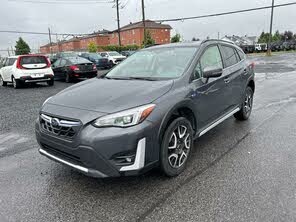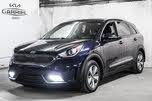Subaru Crosstrek Hybrid vs Kia Niro Hybrid Plug-In
Overview | |
Years produced2014-2016 | Years produced2018-Present |
MSRP$34,995 | MSRP$33,840 |
Listings11 | Listings117 |
Ratings & Reviews | |
User Reviews | User Reviews |
Expert reviews | Expert reviews7.2 out of 10 |
Pros
| |
Reviews Summary | |
Reviews SummaryThe Kia Niro gets redesigned for 2023 model year, but keeps its trifecta of hybrid, plug-in hybrid, and all-electric powertrains. With the demise of its Hyundai Ioniq cousin (not to be confused with the Ioniq 5), the Niro is now the only vehicle sold in North America with those three powertrain options, ranging from a traditional hybrid to a fully electric vehicle. The second-generation 2023 Kia Niro PHEV plug-in hybrid gets the same updates as its Kia Niro Hybrid and Niro EV siblings (which we’ll cover in separate reviews), including dramatic new styling and a revamped interior, plus more power and electric range than the previous-generation Niro PHEV, which dated back to the 2018 model year. The plug-in hybrid market has shifted a bit since that first-generation Niro PHEV was launched. That version was considered significant because it wasn’t derived from a non-electrified model, but that no longer seems to be a priority for automakers or customers. Aside from the Toyota Prius Prime, most mainstream plug-in hybrids are now variants of existing crossovers, such as the Ford Escape PHEV, Hyundai Tucson Plug-In Hybrid, Mitsubishi Outlander Plug-In Hybrid, and Toyota RAV4 Prime—as well as Kia’s own Sportage PHEV. So, the question for the 2023 Niro PHEV is, with plug-in hybrid versions of familiar crossover models now available, does a dedicated design still matter? | |
No video found | No video found |
Popular Features & Specs | |
Engine2.0L 148 hp H4 Hybrid | Engine |
Drive TrainAWD | Drive Train |
Seating Capacity5 | Seating Capacity5 |
EV Battery Capacity8.8 kWh | EV Battery Capacity11.1 kWh |
MPG City36 | MPG City |
MPG Highway35 | MPG Highway |
Battery Charge Time (120V) | Battery Charge Time (120V)8.75 hours |
Battery Charge Time (240V)2 hours | Battery Charge Time (240V)2.25 hours |
Engine | |
Engine Name2.0L 148 hp H4 Hybrid | Engine Name1.6L 180 hp I4 Hybrid |
Torque | Torque195 lb-ft @ 4000 rpm |
Horsepower | Horsepower180 hp @ 5700 rpm |
Battery Charge Time (120V) | Battery Charge Time (120V)8.75 hours |
Battery Charge Time (240V)2 hours | Battery Charge Time (240V)2.25 hours |
DrivetrainAWD | DrivetrainFWD |
Fuel Economy | |
EV Battery Capacity8.8 kWh | EV Battery Capacity11.1 kWh |
MPG City36 | MPG City |
MPG Highway35 | MPG Highway |
Interior | |
Seating Capacity5 | Seating Capacity5 |
Key Features | |
Navigation System | Navigation SystemStandard |
Dimensions & Capacity | |
Cargo Space15.9 cu ft | Cargo Space19.4 cu ft |
Curb Weight3726 lbs | Curb Weight3336 lbs |
Height62.8 in | Height60.8 in |
Length175.8 in | Length174.0 in |
Width79.6 in | Width71.8 in |
Wheelbase104.9 in | Wheelbase107.1 in |
Maximum Payload1175 lbs | Maximum Payload1161 lbs |
Number of doors4 | Number of doors4 |
Maximum Towing Capacity1000 lbs | Maximum Towing Capacity |
Overview | ||
Years produced | 2014-2016 | 2018-Present |
MSRP | $34,995 | $33,840 |
Listings | ||
Ratings & Reviews | ||
User reviews | ||
Expert reviews | 7.2 out of 10Read full review | |
Pros & cons | Pros
| |
Summary | The Kia Niro gets redesigned for 2023 model year, but keeps its trifecta of hybrid, plug-in hybrid, and all-electric powertrains. With the demise of its Hyundai Ioniq cousin (not to be confused with the Ioniq 5), the Niro is now the only vehicle sold in North America with those three powertrain options, ranging from a traditional hybrid to a fully electric vehicle. The second-generation 2023 Kia Niro PHEV plug-in hybrid gets the same updates as its Kia Niro Hybrid and Niro EV siblings (which we’ll cover in separate reviews), including dramatic new styling and a revamped interior, plus more power and electric range than the previous-generation Niro PHEV, which dated back to the 2018 model year. The plug-in hybrid market has shifted a bit since that first-generation Niro PHEV was launched. That version was considered significant because it wasn’t derived from a non-electrified model, but that no longer seems to be a priority for automakers or customers. Aside from the Toyota Prius Prime, most mainstream plug-in hybrids are now variants of existing crossovers, such as the Ford Escape PHEV, Hyundai Tucson Plug-In Hybrid, Mitsubishi Outlander Plug-In Hybrid, and Toyota RAV4 Prime—as well as Kia’s own Sportage PHEV. So, the question for the 2023 Niro PHEV is, with plug-in hybrid versions of familiar crossover models now available, does a dedicated design still matter? | |
Video | No video found | No video found |
Popular Features & Specs | ||
Engine | 2.0L 148 hp H4 Hybrid | |
Drive Train | AWD | |
Seating Capacity | 5 | 5 |
EV Battery Capacity | 8.8 kWh | 11.1 kWh |
MPG City | 36 | |
MPG Highway | 35 | |
Battery Charge Time (120V) | 8.75 hours | |
Battery Charge Time (240V) | 2 hours | 2.25 hours |
Engine | ||
Engine Name | 2.0L 148 hp H4 Hybrid | 1.6L 180 hp I4 Hybrid |
Torque | 195 lb-ft @ 4000 rpm | |
Horsepower | 180 hp @ 5700 rpm | |
Battery Charge Time (120V) | 8.75 hours | |
Battery Charge Time (240V) | 2 hours | 2.25 hours |
Drivetrain | AWD | FWD |
Fuel Economy | ||
EV Battery Capacity | 8.8 kWh | 11.1 kWh |
MPG City | 36 | |
MPG Highway | 35 | |
Interior | ||
Seating Capacity | 5 | 5 |
Key Features | ||
Navigation System | Standard | |
Dimensions & Capacity | ||
Cargo Space | 15.9 cu ft | 19.4 cu ft |
Curb Weight | 3726 lbs | 3336 lbs |
Height | 62.8 in | 60.8 in |
Length | 175.8 in | 174.0 in |
Width | 79.6 in | 71.8 in |
Wheelbase | 104.9 in | 107.1 in |
Maximum Payload | 1175 lbs | 1161 lbs |
Number of doors | 4 | 4 |
Maximum Towing Capacity | 1000 lbs | |

By: CarGurus + AI
At CarGurus, our team of experienced automotive writers remain at the heart of our content operation, conducting hands-on car tests and writing insightful guides that are backed by years of industry experience. To complement this, we are harnessing AI to make our content offering more diverse and more helpful to shoppers than ever. To achieve this, our AI systems are based exclusively on CarGurus content, ratings and data, so that what we produce is both unique to CarGurus, and uniquely helpful to car shoppers.









































